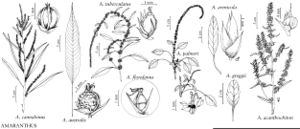Amaranthus greggii
Proc. Amer. Acad. Arts 12: 274. 1877.
Plants glabrous or glabrescent. Stems erect to ascending, much-branched from base, 0.3–1 m. Leaves: petiole shorter than blade; blade ovate, or rhombic-ovate to elliptic, 1.5–4 × 0.5–2 cm, thick, coarse, base cuneate to rounded, margins entire, plane or irregularly undulate, apex rounded-obtuse to emarginate, with terminal mucro. Inflorescences mostly terminal, spikes to panicles, usually erect, thick, flexible. Bracts: of pistillate flowers with short, excurrent midrib, 1.5–2.5 mm, shorter than tepals, apex acute or acuminate; of staminate flowers shorter than tepals, apex acute. Pistillate flowers: tepals with dark, prominent midrib not excurrent, spatulate, subequal, 2–3 mm, apex obtuse to subacute, with terminal mucro; style branches spreading; stigmas 3. Staminate flowers: tepals 5, equal, 2–3 mm, apex obtuse to subacute; inner tepals: with apex indistinctly mucronulate; stamens 5. Utricles light brown, elliptic, 3 mm, equaling tepals, walls somewhat fleshy, smooth, indehiscent. Seeds dark brown, 1.2–1.7 mm diam., shiny.
Phenology: Flowering summer–fall.
Habitat: Coastal sand dunes, sea beaches
Elevation: 0-50 m
Distribution
La., Tex., Mexico.
Discussion
According to J. D. Sauer (1972b), Amaranthus myrianthus Standley most probably is a hybrid between A. arenicola and A. greggii.
Selected References
None.
